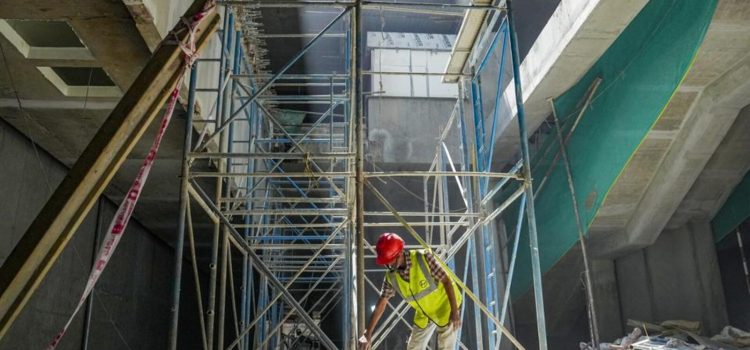
The Supreme Court on Monday stayed a notification by the Union government that exempted building and construction projects, including industrial sheds, schools, colleges and hostels with a built-up area up to 150,000 square metres from obtaining mandatory environmental clearance (EC) prior to starting construction work.
A bench, headed by justice Abhay S Oka, passed the order on a public interest litigation (PIL) filed by Mumbai-based NGO Vanashakti challenging the notification issued by the ministry of environment, forests and climate change (MoEFCC) on January 29 this year on the grounds that it diluted the strict regime governing construction projects. Before the notification came into force, the Environment Impact Assessment (EIA), 2006 made prior environmental clearance mandatory for all constructions with a built-up area of above 20,000 sq meters.
Senior advocate Gopal Sankaranarayanan, appearing for Vanashakti along with advocate Vanshdeep Dalmia, said that this was the fourth attempt by the Centre to carve out an exception for building and construction projects, submitting that similar moves were made by the environment ministry in 2014, 2016 and 2018.
The 2014 move was quashed by the Kerala high court; the 2016 change by the National Green Tribunal (NGT), against whose order an appeal moved by Centre is still pending before the top court; and the 2018 notification was stayed by the Delhi high court in November that year, Sankaranarayanan told the top court.
Noting the pan-India impact of the notification, the bench, also comprising justice Ujjal Bhuyan, said, “Issue notice… In the meantime, stay on the operation of the notification.”
The notification brought in two changes to the existing regime for grant of environmental clearance under Schedule 8 of EIA, 2006 dealing with building and construction projects. It exempted projects with a built-up area up to 150,000 sq m if they were industrial sheds, or schools, colleges and hostels for educational institution, and declared that “general conditions” required under EIA would be inapplicable to this category of projects.
Vansashakti, in its plea, said that exemption of general conditions would affect the appraisal process of such projects in eco-sensitive areas that are protected areas under the Wildlife (Protection) Act, critically and severally polluted areas, and projects located near interstate boundaries. The area exempted, the PIL alleged, is massive as the built-up area of 150,000 sq m would be more than 1.6 million square feet.
A day after passing the notification, MoEFCC came out with an office memorandum (OM) dated January 30 expanding the meaning of “educational institutions” and “industrial sheds” to include private technical institutions, professional academies, universities, warehouses, and industrial sheds housing machinery or raw material.
The petition, filed through Dalmia, stated: “The notification and OM dilute substantive provisions of the EIA, 2006 qua building and construction projects and if permitted to continue, would potentially destroy the land, water and air environment and ecology due to unregulated building and construction activities, that would have a disastrous effect leaving a magnitude of environmental footprint that would be impossible to determine and reverse.”
In court, Sankaranarayanan said, “This can have serious environmental ramifications in the current scenario where building and construction projects are accepted to be one of the principle contributors to air and water pollution.”
He added that the new notification violated a 2003 judgment of the top court in a suo motu case on Maily Yamuna where the need to bring “building and construction sector” within the purview of the EIA regime was first laid down. It was on court’s nudge that the Centre came out with a notification in July 2004 mandating prior environmental clearance for all building and construction projects including townships, colonies, commercial complexes, hotels, hospitals, offices for 1,000 people or more, or discharging sewage more than 50,000 litres per day or with an investment of more than ₹50 crore.
The petition also said the January 29 notification was violative of the Environment Protection Rules of 1986. Rule 5 lays down the requirement for any notification to specify reasons, which were not done. “The removal of the EIA process would have a severe and deleterious impact on the environment as a whole and would contravene the precautionary principle…which is a cornerstone of environmental jurisprudence in the country,” the petition said.
HT reached out to the MOEFCC for a comment but did not get a response till the time of going to print.
“It is shocking that the MoEFCC is constantly trying to help builders rather than doing its job of protecting our environment. I am glad that this notification has been stayed but it needs to be quashed,” said Debi Goenka, Executive Trustee, Conservation Action Trust.
Debadityo Sinha, Lead- Climate & Ecosystems, Vidhi Centre for Legal Policy, said: “Such exemptions undermine the precautionary principle and contradict the principle of sustainable development. The EIA process ensures that any developmental project proceeds only after assessing its potential environmental impact, particularly in ecologically sensitive areas. This mechanism is crucial in preventing ill-conceived and damaging activities. While the Supreme Court’s order is welcome, the real concern is that the Ministry of Environment introduced such a regressive amendment in the first place—one that directly contradicts its mandate under the Environment (Protection) Act, 1986.”











